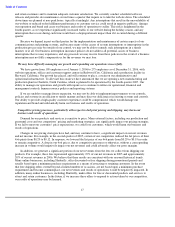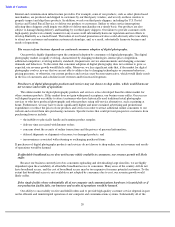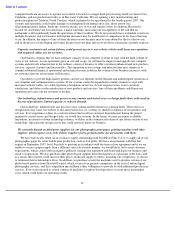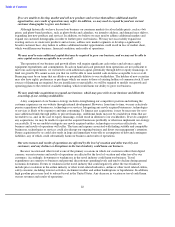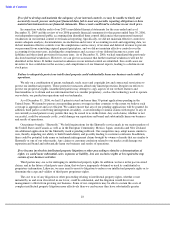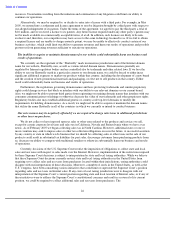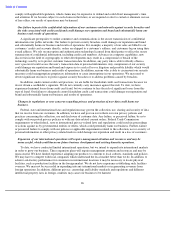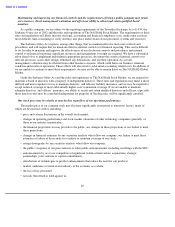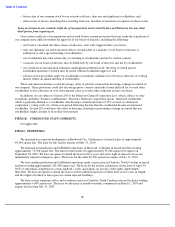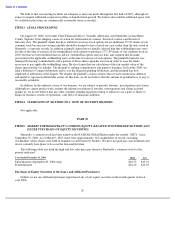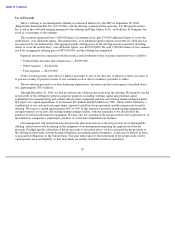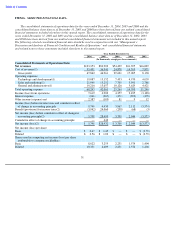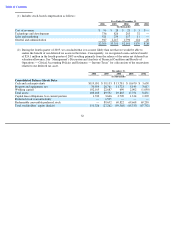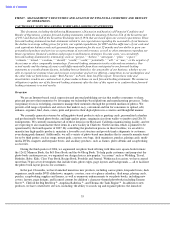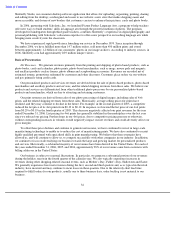Shutterfly 2007 Annual Report Download - page 30
Download and view the complete annual report
Please find page 30 of the 2007 Shutterfly annual report below. You can navigate through the pages in the report by either clicking on the pages listed below, or by using the keyword search tool below to find specific information within the annual report.
Table of Contents
imposition by state and local governments of various taxes upon Internet commerce could create administrative
burdens for us and could decrease our future net sales.
Government regulation of the Internet and e-commerce
is evolving, and unfavorable changes or failure by us to
comply with these regulations could substantially harm our business and results of operations.
We are subject to general business regulations and laws as well as regulations and laws specifically governing
the Internet and e-commerce. Existing and future laws and regulations may impede the growth of the Internet or
other online services. These regulations and laws may cover taxation, restrictions on imports and exports, customs,
tariffs, user privacy, data protection, pricing, content, copyrights, distribution, electronic contracts and other
communications, consumer protection, the provision of online payment services, broadband residential Internet
access and the characteristics and quality of products and services. It is not clear how existing laws governing issues
such as property ownership, sales and other taxes, libel and personal privacy apply to the Internet and e-commerce as
the vast majority of these laws were adopted prior to the advent of the Internet and do not contemplate or address the
unique issues raised by the Internet or e-commerce. Those laws that do reference the Internet are only beginning to
be interpreted by the courts and their applicability and reach are therefore uncertain. For example, the Digital
Millennium Copyright Act, or DMCA, is intended, in part, to limit the liability of eligible online service providers for
listing or linking to third-party websites that include materials that infringe copyrights or other rights of others.
Portions of the Communications Decency Act, or CDA, are intended to provide statutory protections to online
service providers who distribute third-party content. We rely on the protections provided by both the DMCA and
CDA in conducting our business. Any changes in these laws or judicial interpretations narrowing their protections
will subject us to greater risk of liability and may increase our costs of compliance with these regulations or limit our
ability to operate certain lines of business. The Children’s Online Protection Act and the Children’s Online Privacy
Protection Act are intended to restrict the distribution of certain materials deemed harmful to children and impose
additional restrictions on the ability of online services to collect user information from minors. In addition, the
Protection of Children From Sexual Predators Act of 1998 requires online service providers to report evidence of
violations of federal child pornography laws under certain circumstances. The costs of compliance with these
regulations may increase in the future as a result of changes in the regulations or the interpretation of them. Further,
any failures on our part to comply with these regulations may subject us to significant liabilities. Those current and
future laws and regulations or unfavorable resolution of these issues may substantially harm our business and results
of operations.
Legislation regarding copyright protection or content interdiction could impose complex and costly constraints
on our business model.
Because of our focus on automation and high volumes, our operations do not involve, for the vast majority of
our sales, any human-based review of content. Although our website’s terms of use specifically require customers to
represent that they have the right and authority to reproduce the content they provide and that the content is in full
compliance with all relevant laws and regulations, we do not have the ability to determine the accuracy of these
representations on a case-by-case basis. There is a risk that a customer may supply an image or other content that is
the property of another party used without permission, that infringes the copyright or trademark of another party, or
that would be considered to be defamatory, pornographic, hateful, racist, scandalous, obscene or otherwise offensive,
objectionable or illegal under the laws or court decisions of the jurisdiction where that customer lives. There is,
therefore, a risk that customers may intentionally or inadvertently order and receive products from us that are in
violation of the rights of another party or a law or regulation of a particular jurisdiction. If we should become legally
obligated in the future to perform manual screening and review for all orders destined for a jurisdiction, we will
encounter increased production costs or may cease accepting orders for shipment to that jurisdiction which could
substantially harm our business and results of operations.
Our practice of offering free products and services could be subject to judicial or regulatory challenge.
We regularly offer free products as an inducement for customers to try our products. Although we believe that
we conspicuously and clearly communicate all details and conditions of these offers — for example, that customers
are required to pay shipping, handling and/or processing charges to take advantage of the free product offer — we
may be subject to claims from individuals or governmental regulators that our free offers are misleading or do not
25




